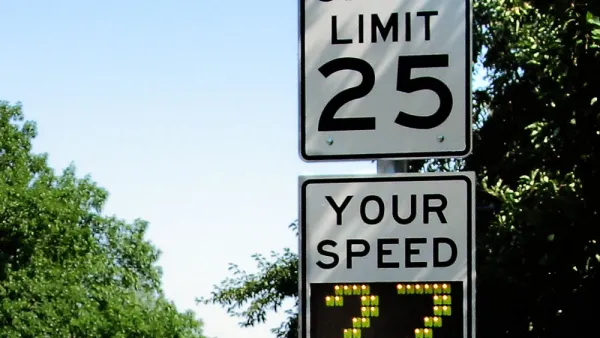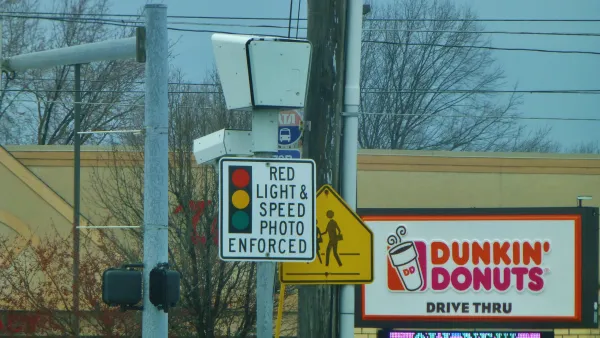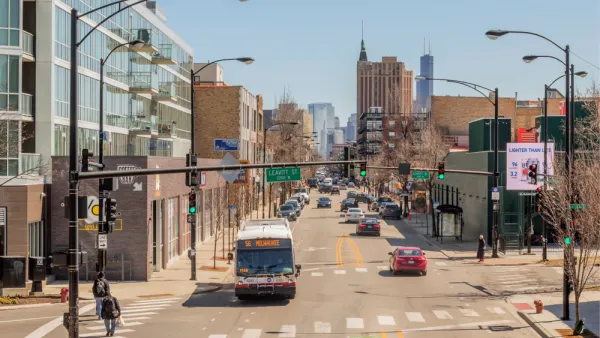A study released by the Insurance Institute for Highway Safety on September 1 showed steep reductions in speeding in Montgomery County, Maryland, where speed cameras has been in effect since 2007, reducing fatalities and severity of injuries.
"A new study released Tuesday shows speed cameras have prompted long-term changes in driver behavior and led to substantial reductions in deaths and injuries," writes David Shepardson, Washington Bureau Chief for The Detroit News. "The cameras are used on residential streets with speed limits of 35 mph or less and in school zones."
“Speed cameras get drivers to ease off the accelerator, and crashes are less likely to be deadly at lower speeds,” said Insurance Institute for Highway Safety President Adrian Lund. “This study connects the dots to show that speed cameras save lives.”
The report was published by the Insurance Institute for Highway Safety (IIHS) "which receives all its funding from car insurance companies," writes Martin Di Caro of WAMU 88.5. Listen here.
It "decided to pick Montgomery County's program — the first in Maryland — because it has been in operation since 2007 and has gone through modifications starting in 2009, when a state law increased the speeding threshold to 12 miles per hour over the posted limit."
"As of 2014, the county had 56 fixed cameras, 30 portable cameras and six mobile speed vans," writes Shepardson. There's no secret where the fixed cameras are located - Montgomery County points them out here, along with the red light camera locations.
The findings are indeed impressive according to the institute's press release, and show great potential in reducing fatalities if used elsewhere.
- Cameras have reduced by 59 percent the likelihood of a driver exceeding the speed limit by more than 10 mph, compared with similar roads in two nearby Virginia counties that don't have speed cameras.
- Overall, the county's camera program in its current form — including the use of corridors and a minor enforcement change that took effect in 2009 — reduces fatal or incapacitating injuries by 39 percent on residential roads with speed limits of 25-35 mph.
- The estimate of 21,000 fatal or incapacitating injuries that cameras could prevent nationwide is based on that reduction.
Spillover effect: Even on streets without cameras, traffic has slowed down. "(D)rivers in Montgomery County are slowing down everywhere as a result of being conditioned by the presence of speed cameras on roads with speed limits of 35 m.p.h. or less," writes Di Caro.
That is not to say they are not without faults, as the "related" articles below for Long Island and Chicago. Particularly jarring is the one about "the tiny town of Elmwood Place, Ohio," where a controversy resulted in a litigation nightmare. CityLab's Sarah Goodyear goes into depth on the problems that erupted. In short, speed cameras may have not escaped the controversies that have clouded the use of red light cameras.
However, as the above video shows, the Montgomery County program has been well received, and citations are decreasing. The goal is to affect driver behavior, not accrue revenue. Speaking of which, here are the penalties, as noted on the county webpage:
- Vehicles traveling 12 miles per hour above the speed limit are issued citations.
- Registered owner of vehicle receives a $40.00 civil citation.
- No points will be issued against the vehicle owner’s driving record.
"Researchers also surveyed county residents; 62 percent say they're in favor of speed cameras on residential streets," wrote Di Caro. "Ninety-five percent were aware of the cameras."
A major distinguishing factor from red light cameras is that speed cameras are still "relatively rare, with only 138 jurisdictions operating such programs as of last month," notes the press release.
While San Francisco Mayor Ed Lee wants to use them, he'll have to find a state legislator to write and pass a bill allowing him to install them. See IIHS table of state laws allow automated traffic enforcement.
This is not the first study to show that speed cameras positively affect driver behavior, saving lives and reducing more serious injuries."A 2010 meta-study of dozens of research papers on speed cameras found a uniformly positive effect on street safety, with a 30 to 40 percent reduction in crashes that cause serious injury or death following the rollout of most programs," wrote Aaron Bialick for Streetsblog SF in January.
Hat tip to AASHTO Daily Transportation Update, Safety sectioin
FULL STORY: Study: Speed cameras reduce traffic crashes

National Parks Layoffs Will Cause Communities to Lose Billions
Thousands of essential park workers were laid off this week, just before the busy spring break season.

Retro-silient?: America’s First “Eco-burb,” The Woodlands Turns 50
A master-planned community north of Houston offers lessons on green infrastructure and resilient design, but falls short of its founder’s lofty affordability and walkability goals.

Delivering for America Plan Will Downgrade Mail Service in at Least 49.5 Percent of Zip Codes
Republican and Democrat lawmakers criticize the plan for its disproportionate negative impact on rural communities.

Test News Post 1
This is a summary

Test News Headline 46
Test for the image on the front page.

Balancing Bombs and Butterflies: How the National Guard Protects a Rare Species
The National Guard at Fort Indiantown Gap uses GIS technology and land management strategies to balance military training with conservation efforts, ensuring the survival of the rare eastern regal fritillary butterfly.
Urban Design for Planners 1: Software Tools
This six-course series explores essential urban design concepts using open source software and equips planners with the tools they need to participate fully in the urban design process.
Planning for Universal Design
Learn the tools for implementing Universal Design in planning regulations.
EMC Planning Group, Inc.
Planetizen
Planetizen
Mpact (formerly Rail~Volution)
Great Falls Development Authority, Inc.
HUDs Office of Policy Development and Research
NYU Wagner Graduate School of Public Service





























